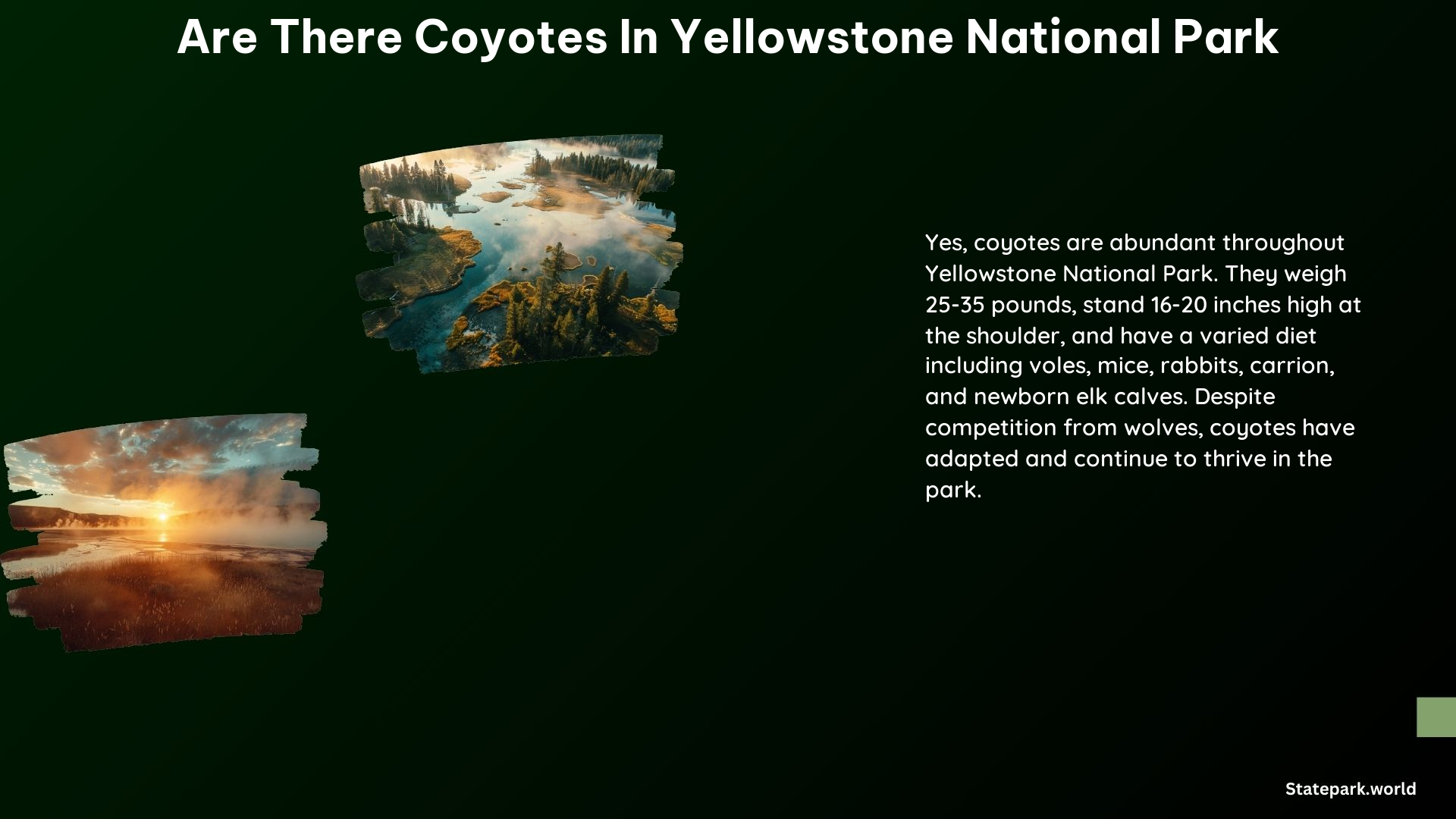Yes, there are coyotes in Yellowstone National Park. Coyotes are a common sight throughout the park, particularly in meadows, fields, and grasslands, as well as along roadways where they forage for small mammals.
The Abundance of Coyotes in Yellowstone
Yellowstone National Park is home to a thriving coyote population. These adaptable canines can be found in various habitats within the park, including:
- Meadows and Grasslands: Coyotes often hunt for small rodents, such as voles and mice, in the park’s vast meadows and grasslands.
- Forested Areas: While less common, coyotes can also be spotted in the park’s forested regions, where they may prey on small mammals and birds.
- Roadsides: Coyotes are known to frequent the park’s roadsides, where they scavenge for food, such as road-killed animals.
The park’s diverse ecosystem and abundant prey base provide an ideal environment for coyotes to thrive. As a result, Yellowstone is home to a robust coyote population that plays a vital role in the park’s overall ecosystem.
Coyote Adaptations in Yellowstone

Coyotes have demonstrated remarkable adaptability in Yellowstone National Park, particularly in the presence of their larger predator, the wolf.
Coexisting with Wolves
When wolves were reintroduced to Yellowstone in the mid-1990s, coyotes faced increased competition for resources and the threat of predation. However, coyotes have adapted to this new dynamic in several ways:
- Spatial Separation: Coyotes have learned to avoid areas where wolves are most active, often shifting their territories and hunting grounds to minimize direct encounters.
- Behavioral Changes: Coyotes have become more cautious and vigilant, altering their hunting and foraging patterns to reduce the risk of confrontation with wolves.
- Dietary Shifts: Coyotes have diversified their diet, relying less on the same prey as wolves and focusing more on smaller, more abundant food sources, such as rodents and carrion.
These adaptations have allowed coyotes to coexist with wolves in Yellowstone, maintaining a stable population within the park.
Exploiting Human Resources
Coyotes in Yellowstone have also adapted to the presence of humans and the resources they provide. While the park encourages visitors to maintain a safe distance from wildlife, some coyotes have become more comfortable around people and have learned to take advantage of human-provided food sources, such as:
- Garbage and Leftovers: Coyotes have been known to scavenge for food in areas where visitors improperly dispose of their trash or leave behind food scraps.
- Pet Food: Coyotes may be attracted to pet food left outdoors, particularly in campgrounds and picnic areas.
- Handouts: Despite park regulations, some visitors may inadvertently or intentionally feed coyotes, leading to increased boldness and reliance on human-provided food.
Park officials work diligently to educate visitors about the importance of maintaining a safe distance from wildlife and properly disposing of food and trash to discourage coyotes from becoming habituated to human presence.
Coyote Behavior and Ecology in Yellowstone
Coyotes in Yellowstone exhibit a range of behaviors and play a crucial role in the park’s ecosystem.
Hunting and Foraging
Coyotes are opportunistic predators, hunting a variety of small mammals, such as voles, mice, ground squirrels, and rabbits. They also scavenge for carrion and take advantage of other food sources, including insects, berries, and even small birds and their eggs.
Denning and Reproduction
Coyotes in Yellowstone typically den in underground burrows, rock crevices, or hollow logs, where they raise their young. Litters typically consist of 4-7 pups, which are born in the spring and remain with their parents for several months, learning essential hunting and survival skills.
Vocalizations
Coyotes are known for their distinctive vocalizations, which include yips, howls, and barks. These sounds serve various purposes, such as communication within the pack, territorial marking, and coordinating hunting efforts.
Interactions with Other Wildlife
Coyotes in Yellowstone interact with a variety of other wildlife species, both as predators and as prey. While they may occasionally prey on young or vulnerable elk, deer, or pronghorn, they are more commonly preyed upon by larger predators, such as wolves and bears.
Coyote Conservation in Yellowstone
Yellowstone National Park actively manages and conserves its coyote population to maintain a healthy and balanced ecosystem.
Monitoring and Research
Park biologists closely monitor the coyote population, tracking their movements, behavior, and interactions with other species. This research helps inform management decisions and ensures the long-term viability of the coyote population.
Visitor Education
Yellowstone National Park places a strong emphasis on educating visitors about the importance of wildlife conservation, including the role of coyotes in the park’s ecosystem. Visitors are encouraged to maintain a safe distance from coyotes and to properly dispose of food and trash to prevent habituation.
Habitat Protection
The park’s vast and diverse habitats provide ample resources and protection for coyotes, ensuring that they can thrive in their natural environment. Yellowstone’s commitment to preserving and restoring these habitats is crucial for the long-term conservation of the coyote population.
Conclusion
Coyotes are a ubiquitous and integral part of Yellowstone National Park’s ecosystem. Their adaptability, resilience, and ecological importance make them a fascinating and valuable component of the park’s diverse wildlife. By understanding and respecting the role of coyotes in Yellowstone, visitors can appreciate the delicate balance of the park’s natural systems and contribute to the ongoing conservation efforts.
Reference:
– Yellowstone National Park – Coyotes
– Yellowstone Coyote Project
– Coyote Ecology and Behavior in Yellowstone National Park
